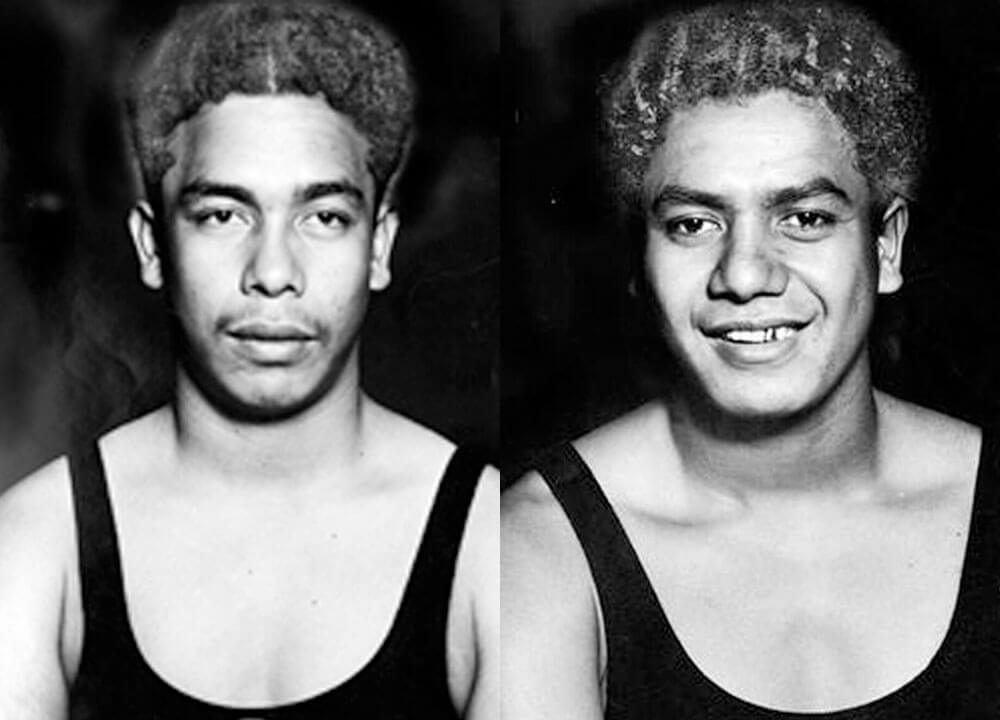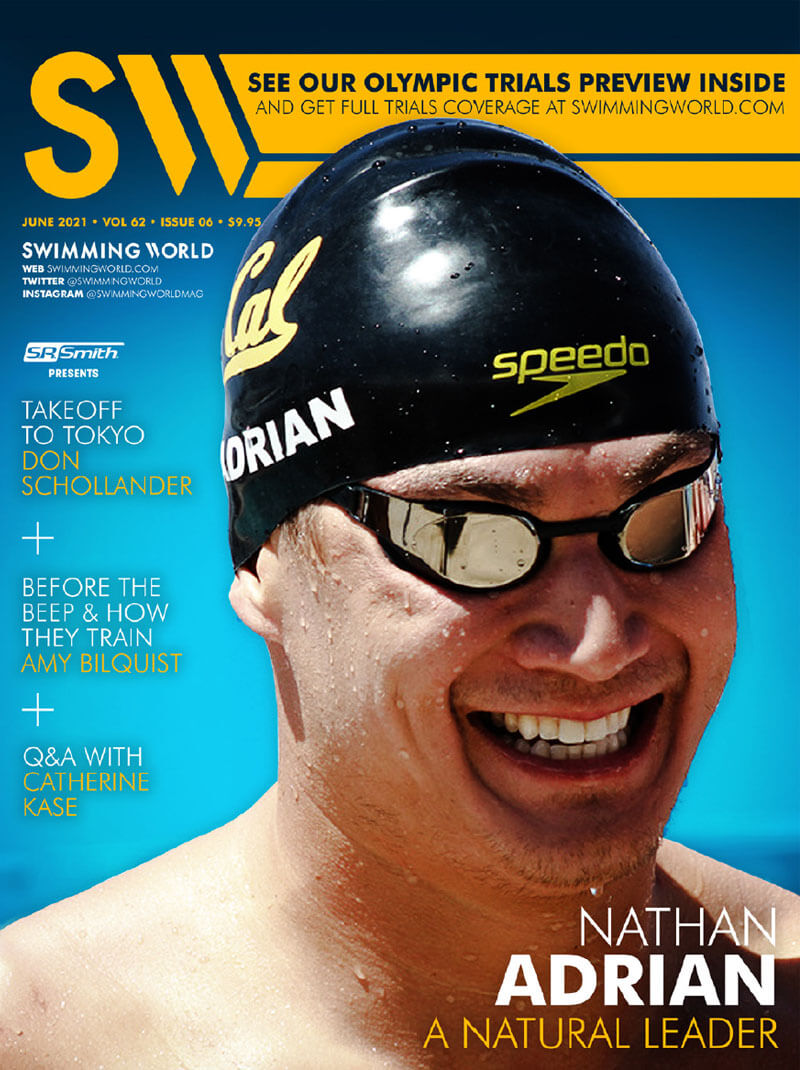Swimming World Presents – Remembering Hawaii’s Kalili Brothers – 90 Years Ago

The latest issue of Swimming World Magazine
is now available for download in the Swimming World Vault!
Non-Subscribers Can Download This Issue Here
Remembering Hawaii’s Kalili Brothers – 90 Years Ago
By Bruce Wigo
As kids who preferred to dive for coins rather than race in a swimming pool, brothers Maiola and Manuella Kalili from Hawaii would eventually become national champions and Olympic silver medalists in 1932.
There’s a photograph that’s been on the wall in the International Swimming Hall of Fame museum for many years. It’s part of the Larry “Buster” Crabbe exhibit, and it shows him as part of the 1931 U.S. men’s national swimming team.
Crabbe (fourth from the left, shown in the photo at the top of the page) and the coach, Bob Kiphuth (far left), are the only members of that team who have been inducted into the ISHOF. The team is standing on the side of a swimming pool wearing traditional Japanese swimwear known as fundoshi. Almost directly in the center of the line of swimmers (sixth from left) is a dark-skinned man with an outstanding Afro. Farther down the line (11th from left) is another dark-skinned man. They are Manuella and Maiola Kalili, brothers who grew up swimming in Hawaii alongside Buster Crabbe, and this is their story.
Maiola and Manuella Kalili were born on the island of O‘ahu in 1909 and 1912. It was said that their father taught them to swim with the idea that they could become another Duke Kahanamoku, and like all of the native Hawaiian boys, water was their playground. But their early desire was not for competition—it was diving for coins thrown in the harbor of Honolulu by tourists on incoming and outgoing steamships. Their parents’ disappointment ended with the arrival of Harvey Chilton, the coach who started the Hui Makani Swim Club and started recruiting diving boys for his team.
TRIPLE THREAT
In the late 1920s and early 1930s, the trio of Crabbe and the Kalili brothers dominated American swimming like no trio from the same club before or after. But at the 1930 AAU Nationals in Long Beach, Calif., it was a two-man show. Buster Crabbe and Maiola Kalili won four of the national championships, and they placed second in five races.
In every event won by Crabbe, Kalili was second. Crabbe was runner-up in the race won by Kalili. In addition, Maiola was second in the backstroke, being barely outtouched by George Kojac, the 1928 Olympic champion and world record holder. But it was Maiola Kalili who was the talk of the meet: for “his style was the most relaxed and easy of any of the competitors, including Crabbe.”
I haven’t been able to find out why Manuella didn’t compete in Long Beach, but the brothers had earlier been invited to compete in the Japanese nationals in Tokyo later that summer. Fatigue from the journey and exhaustion from competing in every event but the breaststroke, the brothers refreshed enough to win two events, bettering Japanese national records: Maiola in the 100 meter backstroke and Manuella in the 100 freestyle.
The 1931 AAU Outdoor Nationals were held in Hawaii’s War Memorial Natatorium. In this meet, the Kalili brothers were swimming under the banner of the Hollywood AC, while Buster Crabbe represented the Los Angeles AC, coached by Fred Cady, his coach at USC.
Once again, it was the Buster Crabbe and Maiola Kalili Show. The first day started in the afternoon with Crabbe winning the 1500 and Maiola finishing fourth. In the evening, Manuella outtouched his older brother, Maiola, to win the 100 free, while Crabbe watched from the sidelines.
On Day 2, there was a touch of humor in the 400 after Crabbe jumped off to a false start. As he went to the side of the pool to climb out, Maiola rushed over to him and extended his hand to pull him out. “You almost beat the gun,” he said as both walked back to the starting blocks. But it was Buster who got the last laugh, as he pulled away from his rival on the final lap. Later, Maiola revived enough to win the 200 backstroke. On the third day,
Crabbe displayed reserve power again to take down Maiola Kalili and win the 300 individual medley, with Manuella placing third.
On the fourth and final day, it was the 800 freestyle that would determine the high-point award winner. Like their other races, it came down to the last individual event on the program. Crabbe went four-for-four and not only nosed out Kalili for the 800 title, but won the high-point trophy by a half-point, 20 to 19-1/2, which included 2-1/2 points for the 800 relay. Manuela was third with 9-1/2 points. At the luau following the last event, it was learned that after having been training in the States, Manuella couldn’t resist the call of the harbor. Beyond a big smile, he refused to disclose how much he collected each morning of the meet diving for coins.
Get Swimming World Magazine and Swimming World Biweekly FREE When You
Become A Member of the International Swimming Hall of Fame
New! 30 Day Membership to ISHOF AND Digital Swimming World Subscription for just $10 a month!
Want more? Get a 1 Year ISHOF Family Membership With Swimming World Print AND Digital Subscription Order Now!
Non-Subscribers can click here to download this issue for only $5.94
Swimming World June 2021 Issue
FEATURES
12 | U.S. OLYMPIC TRIALS PREVIEW
by David Rieder
The fastest swimmers in the United States will be putting their hopes and dreams on the line at the U.S. Olympic Team Trials-Swimming, June 13-20, in Omaha, Neb. If realized, they’ll have the opportunity to perform next month on the world’s grandest stage: the Olympic Games in Tokyo.
22 | A NATURAL LEADER
by John Lohn
Still producing elite-level performances, Nathan Adrian, now 32 and pursuing his fourth Olympic Games, has the opportunity to further his already lofty reputation. And whenever his days in the sport come to an end, Adrian will be viewed for his excellence in the sport as an athlete, teammate and ambassador.
25 | NJCAA CHAMPIONSHIPS: QUALITY & QUANTITY
by Andy Ross
That’s the same winning formula that Indian River’s men’s and women’s swimming and diving teams have been using for nearly a half-century at the NJCAA Championships. The Pioneer men now have won 47 straight team titles; the women, 39—and 43 of the past 47.
26 | TAKEOFF TO TOKYO: A FORGOTTEN STAR
by John Lohn
By all measures, Don Schollander is a legend in the sport, a Hall of Fame talent who was unrivaled in his heyday. Yet, his impact has been lost to a combination of unfortunate timing and modern-day fascination.
29 | DOMINANCE AND PARITY ON DISPLAY IN TOKYO
by Dan D’Addona
While the U.S. women have dominated international water polo since 2015—winning their second straight Olympics in 2016 plus three World Championships in 2015-17-19—a different men’s champion has emerged at each of the last three major international competitions—Serbia (2016 Olympics), Croatia (2017 Worlds) and Italy (2019 Worlds).
30 | ISHOF: REMEMBERING THE KALILI BROTHERS—90 YEARS AGO
by Bruce Wigo
As kids who preferred to dive for coins rather than race in a swimming pool, brothers Maiola and Manuella Kalili from Hawaii would eventually become national champions and Olympic silver medalists in 1932.
33 | NUTRITION: HOW MANY CALORIES SHOULD I EAT?
by Dawn Weatherwax
As long course, Olympics and endurance events get underway, a common question is: “How much do I need to eat?” This is a loaded question—one in which the author will try to simplify.
35 | MENTAL PREP: BEFORE THE BEEP WITH AMY BILQUIST
by Shoshanna Rutemiller
COACHING
38 | SWIMMING TECHNIQUE CONCEPTS: MAXIMIZING SWIMMING VELOCITY (Part 2)—STROKE CYCLE PHASES
by Rod Havriluk
Swimmers typically decrease non-propulsive time to decrease stroke time, increase stroke rate and swim faster. Research shows that a further decrease in the non-propulsive time is possible and should produce further performance improvement.
40 | A COACHES’ GUIDE TO ENERGY SYSTEMS
by Michael J. Stott
In the first of two parts, Swimming World explores the concept of energy systems and how coaches can use them to maximize athlete development and performance.
42 | SPECIAL SETS: KATIE LEDECKY—RUN-UP TO RIO 2016
by Michael J. Stott
With this month’s Olympic Swimming Trials now upon us, Swimming World takes a back-to-the-future approach to revisit some training done by superstar Katie Ledecky prior to the 2016 U.S. team qualifying meet.
44 | Q&A WITH COACH CATHERINE KASE
by Michael J. Stott
45 | HOW THEY TRAIN HALEY ANDERSON
by Michael J. Stott
TRAINING
037 | DRYSIDE TRAINING: TRAINING AMY BILQUIST
by J.R. Rosania
JUNIOR SWIMMER
47 | UP & COMERS: KEELAN COTTER
by Shoshanna Rutemiller
COLUMNS
08 | A VOICE FOR THE SPORT
11 | DID YOU KNOW: ABOUT BUSTER CRABBE?
48 | GUTTERTALK
49 | PARTING SHOT
Swimming World is now partnered with the International Swimming Hall of Fame. To find out more, visit us at ishof.org




